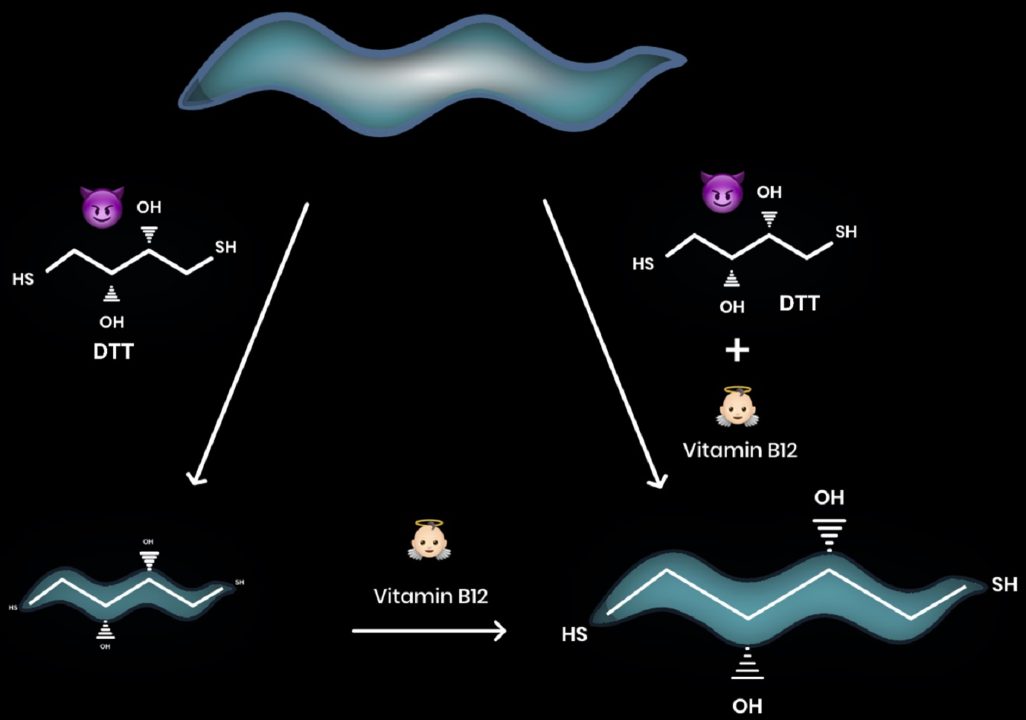
Vitamin B12 Protects from Thiol Antioxidant Toxicity
- News
- 4.3K
A team of researchers at the Indian Institute of Science Education and Research (IISER), Mohali has revealed that the thiol reducing agent Dithiothreitol (DTT) causes toxicity by reducing the levels of an important regulatory molecule known as S-adenosylmethionine, and vitamin B12 could protect against this toxicity. The results of this study on the C. elegans (roundworms) model system have been published in the journal eLife.
Animal and plant cells synthesize a significant fraction of their proteins in a cellular compartment known as the Endoplasmic Reticulum (ER). The ER provides an oxidative environment required for the proper assembly of proteins. There are many small chemical molecules that can change the environment of the ER and could affect the proper assembling of proteins. One such molecule is DTT, a thiol antioxidant that researchers often use to specifically target ER compartment to learn more about its role. Research suggests that DTT works by disturbing the complex chemical environment present in the endoplasmic reticulum, which is required for the proteins to assemble properly. However, it is not understood whether DTT can modulate any other compartment of the cell as well.
“DTT possesses antioxidant properties, and therefore, it becomes even more critical to characterize its effects on the physiology of the cell completely. Therefore, we aimed to study the effects of DTT on the cellular physiology of an organism using the millimeter-long roundworm Caenorhabditis elegans,” says Dr. Jogender Singh, Ramalingaswami Re-entry Fellow and Assistant Professor at the Department of Biological Sciences, IISER, Mohali.
While studying DTT toxicity, the research team serendipitously observed that DTT toxicity in C. elegans was highly dependent on its bacterial diet. They discovered vitamin B12 as the bacterial metabolite that could reduce the toxic effects of DTT. Further, the research team also discovered that DTT resulted in the depletion of the important regulatory molecule S-adenosylmethionine in C. elegans. Because vitamin B12 is involved in the synthesis of methionine, which is a precursor for S-adenosylmethionine, it made sense why vitamin B12 reduced DTT toxicity.
In a cell, the synthesis of methionine and S-adenosylmethionine takes place in the cytoplasm, which is a thick solution that fills the cell and excludes the endoplasmic reticulum. Therefore, according to this study, the chemical reaction that DTT is targeting occurs outside the endoplasmic reticulum. “The primary reason for the toxic effects of DTT lies outside the endoplasmic reticulum! These results provide a new mechanism of action of DTT on cell physiology and suggest that DTT should be reconsidered for use in endoplasmic reticulum studies,” says Dr. Singh.
The study demonstrates that DTT can be used to modulate the levels of S-adenosylmethionine. “Since reduced levels of S-adenosylmethionine are associated with better health and lifespan in a variety of organisms, DTT could have health-promoting effects when administered in small doses,” says Dr. Singh.
“It will be intriguing to test whether, at non-toxic concentrations, DTT could have health-improving effects,” he added.
The study has provided new insights into the usage of antioxidants, and might help to understand the functionality of other thiol antioxidants, some of which are used as food supplements.
If you liked this article, then please subscribe to our YouTube Channel for the latest Science & Tech news. You can also find us on Twitter & Facebook


